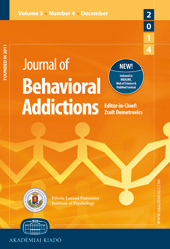Compulsive sexual behavior among male military veterans: Prevalence and associated clinical factors
Compulsive sexual behavior among male military veterans: Prevalence and associated clinical factors
Author(s): Philip H. Smith, Rani A. Hoff, Crystal L. Park, Sherry A. McKee, Carolyn M. Mazure, Marc N. PotenzaSubject(s): Psychology, Clinical psychology, Behaviorism, Studies in violence and power, Health and medicine and law, Demography and human biology
Published by: Akadémiai Kiadó
Keywords: compulsive sexual behavior; military; PTSD; child abuse; veterans; trauma;
Summary/Abstract: Compulsive sexual behavior (CSB) is highly prevalent among men, often co-occurring with psychiatric disorders and traumatic experiences. Psychiatric disorders and trauma are highly prevalent among military veterans, yet there is a paucity of research on CSB among military samples. The aim of this study was to examine the prevalence of and factors associated with CSB among male military veterans. Methods: Surveys were administered to veterans of Operations Iraqi Freedom, Enduring Freedom, or New Dawn at baseline (n = 258), 3 months (n = 194), and 6 months (n = 136). Bivariate analyses and Generalized Estimating Equations were utilized to estimate associations between CSB and the following variables: psychiatric co-morbidity, childhood physical or sexual trauma, pre- and post-deployment experiences, TV/ Internet usage, and sociodemographics. Associations between CSB and specific PTSD symptom clusters were also examined. Results: CSB was reported by 16.7% of the sample at baseline. Several variables were associated with CSB in bivariate analyses; however, only PTSD severity, childhood sexual trauma, and age remained significant in multivariable GEE models. The PTSD symptom cluster re-experiencing was most strongly associated with CSB. Discussion: This exploratory study suggests that CSB is prevalent amongst veterans returning from combat and is associated with childhood trauma and PTSD, particularly re-experiencing. Conclusions: Further study is needed to identify the mechanisms linking PTSD and CSB, define the context and severity of CSB in veterans, and examine the best ways to assess and treat CSB in VA clinical settings.
Journal: Journal of Behavioral Addictions
- Issue Year: 3/2014
- Issue No: 4
- Page Range: 214-222
- Page Count: 9
- Language: English

